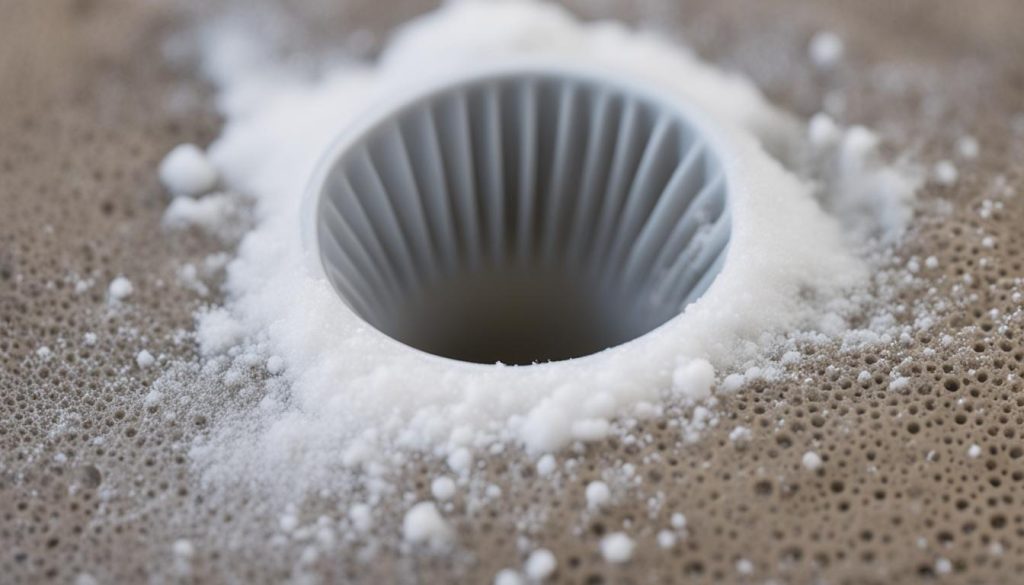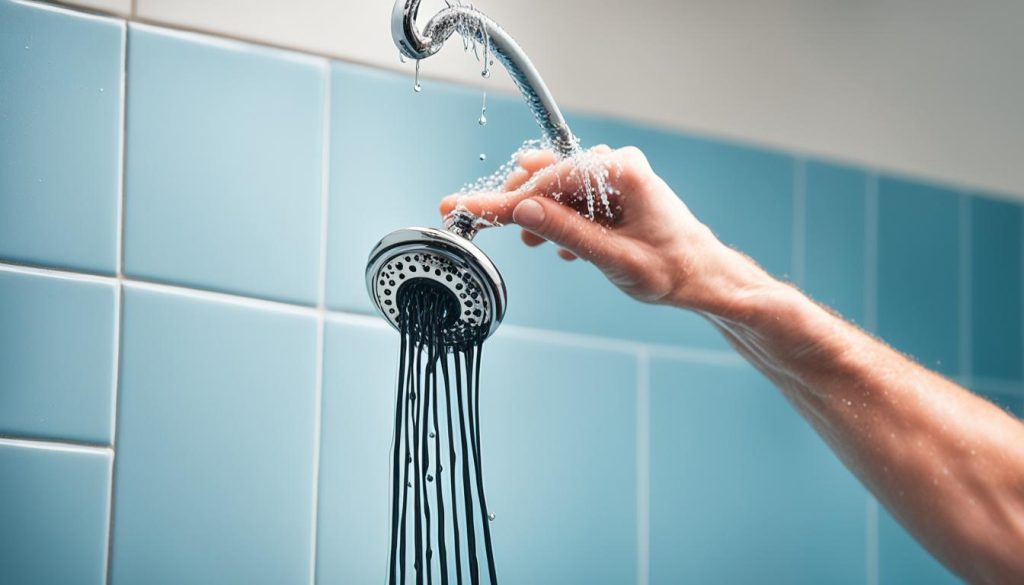Unclog Your Shower: Dissolve Hair in Drain Easily
Did you know that on average, a person can shed up to 100 hairs a day? That’s a significant amount of hair that ends up in our drains, causing clogs and blockages. If you’ve ever dealt with a clogged shower drain due to hair buildup, you know how frustrating and unpleasant it can be. But fear not, there are simple and eco-friendly ways to dissolve hair in your shower drain and keep it flowing smoothly. In this article, I’ll share effective DIY methods and hair-friendly drain cleaners to help you unclog your shower drain with ease.
Key Takeaways:
- Regularly unclogging your shower drain helps prevent clogs and keeps the water flowing smoothly.
- Using boiling water, baking soda and vinegar, or a hair removal tool are eco-friendly and effective methods to dissolve hair in your shower drain.
- If DIY methods don’t work, consider using a hair-friendly chemical drain opener or calling a professional plumber.
- Maintaining healthy drain habits, such as using a drain strainer and periodically cleaning your drain, can help prevent hair buildup and clogged drains in the future.
- Remember to always use caution and protective equipment when handling chemicals or removing hair manually from the drain.
Use Boiling Water
One simple and effective method to unclog hair from your shower drain is by using boiling water. Boil a pot of water on the stove, then carefully pour it down the drain. The hot water can help loosen up soap and grease that may be holding the hair in place, allowing it to flush down properly. This method is easy to do and doesn’t require any additional materials or tools.
Why Boiling Water Works
Boiling water is a powerful and effective natural cleaner that can help dissolve hair and clear clogs in your shower drain. Here’s why it works:
- Heat: Boiling water can break down and soften soap and grease that may be trapping hair in the drain.
- Flushes: The force of the boiling water flushing down the drain can dislodge hair and push it through the pipes.
- No additional materials: This method simply requires water, making it a convenient and cost-effective solution for clearing hair clogs.
Using boiling water to unclog your shower drain is a quick and easy DIY method that can provide effective results. However, it’s essential to exercise caution when handling boiling water to prevent burns or accidents.
| Pros | Cons |
|---|---|
| Easy and cost-effective | May not work for severe or stubborn clogs |
| Doesn’t require additional materials | Can be dangerous if not handled properly |
| Environmentally friendly | May not remove all hair and debris from the drain |
Try Baking Soda & Vinegar
When it comes to drain cleaning and dissolving hair buildup in your shower drain, one simple and effective DIY method involves using baking soda and vinegar. This natural solution can help break down hair clogs and keep your drain flowing smoothly.
To try this method, start by pouring a cup of baking soda directly into the drain. Baking soda is known for its cleaning and deodorizing properties, making it an excellent choice for unclogging drains.
Next, carefully pour a cup of vinegar into the drain. The combination of baking soda and vinegar creates a foaming reaction that helps dissolve hair and other blockages.
Allow the mixture to sit in the drain for a few hours, giving it time to work its magic. During this time, the baking soda and vinegar will gradually break down the hair buildup, making it easier to remove.
After the recommended waiting period, it’s time to flush out the dissolved hair, vinegar, and baking soda. Boil a big pot of water and carefully pour it down the drain, ensuring that it reaches all the way to the clog. The hot water will help flush out any remaining residue and leave your drain clean and clear.
This DIY method is both cost-effective and eco-friendly, as it does not rely on harsh chemicals or tools. By using baking soda and vinegar, you can effectively dissolve hair buildup in your shower drain and prevent clogs from recurring.
Use Your Hand
While it may not be the most appealing method, using your hand can be one of the most effective ways to remove a hair clog from your shower drain. Start by removing the drain cover and reach inside the drain to pull out the hair. It’s recommended to wear gloves to avoid direct contact with the hair. Try to grasp a clumped-up part of the hair to remove the entire clog in one go. If needed, use a flashlight to locate and grab the hair that may not be easily visible. This hands-on approach can quickly clear a clog.
Step-by-Step: How to Use Your Hand to Remove a Hair Clog
- Begin by removing the drain cover. Use a screwdriver or unscrew the screws, depending on the type of cover.
- Put on a pair of gloves to protect your hands from direct contact with the hair and any potential debris.
- Reach inside the drain and locate the hair clog. Depending on the length of the drain, you may need to insert your fingers deeper.
- Try to grab onto a clumped-up part of the hair and pull it out in one motion. Be careful not to break the hair or push it further into the drain.
- If necessary, use a flashlight to locate and grab any hair that may be difficult to see.
- Dispose of the hair in a trash bag or bin.
- Replace the drain cover by screwing it back into place.
- Run water down the drain to ensure the clog has been completely removed.
Using your hand to remove a hair clog can be a quick and effective method. It allows you to physically remove the hair and clear the drain without the use of chemicals or tools. However, if you find this method uncomfortable or if the clog persists, you can try other methods mentioned in this article.
Get a Hook
If you’re uncomfortable using your hand, another option is to use a hook to pull out the hair clog. You can easily create a hook by bending a thin piece of wire, like a coat hanger. Insert the hook into the drain, try to catch the hair, and gently pull it up. Be careful not to bend or break the hook and try to remove the entire clog without it breaking off and falling back into the drain. Some drain-cleaning chemicals come with a hook-like device for this purpose, which can be a convenient option if you prefer.
Pour Some Chemicals Down There
If the previous methods haven’t been successful, you can consider using a chemical drain opener as a last resort. However, it’s important to use these chemicals with caution as they can be harsh on your pipes and harmful if mishandled. Look for a drain opener specifically designed for unclogging drains, including those with hair buildup.
- Follow the instructions on the packaging carefully.
- Always use proper protective equipment, such as gloves, goggles, and old clothes.
- It’s important to note that chemicals should be used sparingly and as a last resort to prevent damage to your pipes.
While chemical drain openers can be effective in unclogging your shower drain, it’s crucial to prioritize safety and minimize potential harm to your plumbing system.
In the next section, we’ll explore another DIY method that can help you tackle stubborn clogs before resorting to professional assistance.
Break Out the Plunger
If you have a larger-sized shower drain and none of the previous methods have worked to unclog it, it’s time to break out the plunger. Using a plunger can be an effective way to dislodge stubborn hair clogs and restore the flow of water in your shower drain.
Here’s how you can use a plunger to unclog your shower drain:
- Fill your shower with a small amount of water, enough to cover the lip of the plunger.
- Place the plunger over the drain to create a tight seal.
- Apply downward pressure on the plunger and start plunging vigorously.
- The suction and pressure created by the plunger will help dislodge the hair clog and allow it to flow down the drain.
- Once you’ve plunged several times, test the drain by running water to see if the clog has been cleared.
If the water drains properly, congratulations! You’ve successfully unclogged your shower drain using a plunger. If the clog persists, you may need to try other methods or consider calling a professional plumber.
Remember, plunging may not always be the most effective method for every type of clog, but it’s a simple and accessible solution to try before seeking professional help.
Call a Professional
If all else fails and you’re unable to unclog your shower drain, it’s time to call a professional plumber. They have the expertise and proper tools to handle stubborn clogs that can’t be cleared with DIY methods.
Contact a trusted plumbing service and explain the issue you’re facing. A professional plumber can provide you with valuable tips or schedule an appointment to assess and resolve the clog.
Sometimes it’s best to leave it to the professionals to ensure the problem is resolved effectively and safely. Don’t hesitate to call a professional plumber for assistance in unclogging your shower drain.
- Investing Wisely: How Windows & Doors in Boost Property Value and Financial Health - April 24, 2025
- The Financial Impact of Personal Injuries: Why Legal Help Matters for Business Owners - April 16, 2025
- The Hidden Financial Costs of Domestic Assault: What Business Owners Need to Know - April 16, 2025














